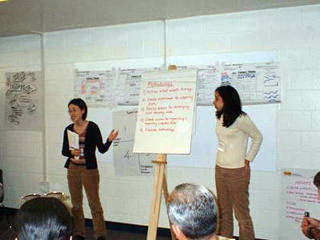Course Description
This workshop explores the potential of media technology and the Internet to enhance communication and transform city design and community development in inner-city neighborhoods. The class introduces a variety of methods for describing or representing a place and its residents, for simulating actions and changes, for …
This workshop explores the potential of media technology and the Internet to enhance communication and transform city design and community development in inner-city neighborhoods. The class introduces a variety of methods for describing or representing a place and its residents, for simulating actions and changes, for presenting visions of the future, and for engaging multiple actors in the process of envisioning change and guiding action. Students will engage one neighborhood, meet real people working on real projects, put theory into practice, and reflect on insights gained in the process.
This year the course will examine what it means to be an urban designer/planner and how to create a digital teaching tool (using digital storytelling) that supports others in learning about the relationship between design and planning professionals, on the one hand, and members of the communities they serve, on the other. What is the nature of the knowledge that resides in a community and how can designers and planners learn about, tap, and use that knowledge? What is the relationship between community organizing and urban design and planning? What are the relationships between you as a professional, the place(s) in which you work, and the values and care you bring to that work?
We will explore these themes in the context of Camfield Estates in Lower Roxbury, MA and its participation in the US Department of Housing and Urban Development’s (HUD) Demonstration Disposition Project. There have been many stories written about Camfield Estates’ participation in the Demonstration Disposition project, for it has been widely regarded as a model of success. There are two stories that have not yet been told, however: the story of the residents who organized the community and the story of the architects and planners who participated in the project. This course will use digital storytelling to reconstruct and connect these two stories.
Course Info











